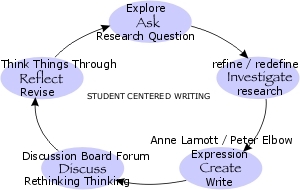All of us know the experiences of writing, the tensions, frustrations, anxieties surrounding the completion of an essay; we are also aware of the innate contradictions within the social context of academic writing. Anyone who has taken college writing courses knows that teachers of writing do not always agree about what abilities you will need to be a successful writer.
I want to talk about a potentially different approach to writing a draft, practicing what might best be called student-centered writing as a way of creating and framing drafts of new ideas. Donald Murray, a notorious teacher of writing, tells us that as writers we should expect the unexpected, cultivate surprise as the purpose of writing. Write to discover what you think. This way of approaching academic writing has been around for awhile and yet in my mind needs more emphasis. Rather that writing for the teacher, to and for an authority figure who designates the subject, consider writing as a drama where great ideas potentially occur by accident, through the process of writing in the first place. The process of inquiry begins with side-lining the subject-centered approach (which does not mean, however, that you do not respond to the task assigned). As an alternative, initiate a student-centered approach, i.e,. where the writer resides at the center of the essay, not the topic. The spirit of inquiry places the writer in the middle as an investigator.
I resist placing an actual image of the Venn Diagram here, but it can be useful, in that, the diagram illustrates the importance of locating your place in the center between the assigned task and your own interests. As the prominent scholar of mythology, Joseph Campbell, once said, "follow your bliss." This advice directly characterizes student-centered writing. Using this place in the middle, the writer asks a research question that he or she will investigate in the essay. Think about why it matters not only to you, but also to your readers. Explain why your question is significant. Writers are trying to figure things out and sharing their ideas with others because doing so is important. There is a social purpose for writing-- second only to the primary purpose of cultivating surprise. We determine whether or not the topic is "researchable" and we proceed as writers with the task of developing a working knowledge of the subject. In this case we can apply Kenneth Burke's famous concept of an unending conversation. As writers at the center of the essay, we see ourselves as participants in a conversation.
When we are writing from the middle, we still need to focus on research. I see research as participating in the unending conversation as well; research is conversation and often the ideas that make for a great paper come out of doing research first, not the other way around. Still writers can easily get bogged down by their own research when writing a draft. There is no panacea solution when it comes to the encroaching feelings that might best be described as "overwhelmed by the task." Peter Elbow helps us out. So does Anne Lamott.
I offer the following image as a circular
strategy for practicing student-centered writing.

Research suggests the students do better when the can place themselves in the middle of the writing process; find some personal connection that gives you a central role--voice and authenticity matter. However research also says that you cannot go it alone. Indeed, in most all successful learning models, evidence says that student isolation--missing the unending conversation--leads to mediocrity. The data suggests that participation in the Discussion Board Forums will advance the abilities you need to succeed as a writer. We think things through. We collaborate with others.
Also I include a link to an animation video at TEDEd called Rethinking Thinking by Trevor Maber. The animation can be applied to the writing process if we use our imagination just a bit. Trevor gives us a ladder as metaphor, which can help writers evaluate the process of reflection and revision in the student centered writing process. His example of the incident in the parking lot may not appear to have anything to do with writing: however, I invite you to return to the Universal Standards of depth and breadth (in particular) and as well consider "where and when" (on your way up the ladder) you need to examine your assumptions, some of which are supported and reinforced, indeed reproduced, by our social institutions, whether those are state based, like the army or the judicial system, or seemingly as private as the family and the school, the art museum and the institutions of the media, the church and the small-claims court.
http://ed.ted.com/lessons/rethinking-thinking-trevor-maber
I also suggest that we may in this process travel around this circle more than once. We ask the "So What?" question. We evaluate the way we present information: we make sure that the reader can see our mind at work at the center of the essay. We make sure we are doing more than conveying data and observations. Writers at the center focus on their voice and their perspective.